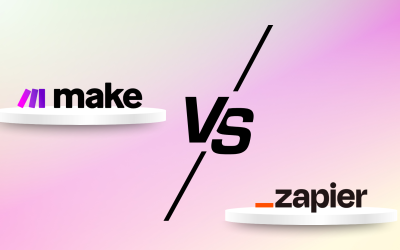Why Business Process Automation is No Longer Optional in 2025
To run a successful business in 2025 is not as easy as it seems. The competition is vast, customers look at your business with some expectations, you got to be their solution provided within minimal period of time and if you fail to do that the downfall is approaching.
For a business to not miss out on great opportunities needs faster, smarter, leaner operation than before. You may focus on innovation and expansion, save resources, and minimize errors by automating repetitive processes and simplifying complex processes.
You can boost your business’s productivity and efficiency by up to 30%. And this is easily possible with Business Process Automation. It reduces errors and accelerates operations with automation tools. Automating your business is essential to staying ahead in the fast-paced world of today.
Automation of business processes is the key to a more effective and successful organization. Automation tools boost your capabilities, decrease errors, and simplifies work. But when it comes to business process automation, where do you start? How can you develop and thrive with automation tools?
What is Business Process Automation?
Business Process Automation is to use of technology to automate the business process. Any collection of steps intended to accomplish a goal is referred to in this context as a “business process,” especially when they include several IT systems and are highly repetitive. Businesses can use BPA to automate whole processes or even specific steps in a bigger process, depending on what best suits their needs.
Business Automation allows businesses to standardize their workflows, enables cost savings, and enhances productivity gains. For the similar reason, Business Automation is also known as Workflow Automation.
Also here, people are getting confused between Business Process Automation and Business Process Management. To clear the confusion, let me tell you what business process management is. An organization uses business process management as an organizational discipline to examine and assess its current procedures like Identifying opportunities for improvement, develop strategies to implement the enhancements, and follow upon the strategy.
Being familiar with Modern Business Process Automation
Business Process Automation helps companies make their business workflows run smoothly and efficiently. This Automation technology ease up the repetitive and manual task so that employees can focus on more important things that is to be done in the business.
Businesses only want top performance and for that it becomes even more important to have business process automation. It helps businesses with new levels of performance, innovation and customer satisfaction. With this approach your business can grow, stay ahead of the competition and making automation becoming the main part of the business process.
Implementation of Business Process Automation:
The goal of implementing BPA is to increase daily operations efficiency and create a competitive edge overall. So, what should you keep in mind when you intend to apply it? Which procedures ought to be given priority? Which implementation strategies are most effective?
- Start slowly; don’t include every step right away. It will take a lot of time. If you spend too much time automating everything, you risk becoming sluggish and losing the market to competitors.
- Consider the future when choosing the instruments and technologies to advance. Considering scalability and cross-platform transferability is necessary.
- Individuals can start by creating their workflows and managing their activities by hand. They might, however, run into process bottlenecks and find ways to increase productivity. Where necessary, automation solutions can then be implemented.
- Selecting a custom automation platform will help you automate more effectively in the long term, if at all possible. Implement change management strategies, such as meetings, hand-holding sessions, training, and tutorials. Track and evaluate the procedures.
The Best Ways to Implement Business Process Automation
There are a few more actions you may take to guarantee the success of BPA in your company, in addition to choosing which operations to automate:
- Clearly define your objectives and expectations. This accomplishes three main goals: It first creates a business case for BPA, which helps you defend your BPA technology investment. Second, you may use it as a starting point to create a strategic plan for your business process automation project. Our second-best practice is that it allows you to measure the ROI and success of your BPA program.
- Recognize the compliance needs of your company. When creating a business process automation strategy, it’s crucial to consider potential requirements, constraints, and restrictions, even if you aren’t automating a process (or processes) as part of your compliance program.
- Analyse your outcomes. Make sure to specify whatever metrics or key performance indicators (KPIs) you plan to use to track the progress of your BPA program. For instance, you should track the automation’s outcomes to determine whether it is providing the desired benefit if you are attempting to cut costs or time for a business process.
- Keep a record of everything. Make sure that every part of your business process automation strategy is carefully documented and that the documentation is available to all key staff. This includes knowing what changes are being made to the current workflow and how you plan to implement those changes. By establishing this one source of truth, all misunderstandings will be resolved and the new procedure will be continuously followed to.
- Make training investments for your employees. Not only should training contents explain the new procedure and the updated roles and duties of personnel, but they should also provide a justification for the change. A key component of change enablement is helping staff in comprehending the “why” behind business process automation, which raises the possibility of user adoption and the overall success of any BPA project.
- Begin with baby steps and gradually increase. Identifying three to five procedures that would benefit from automation is preferable to attempting to automate everything at once. It will quickly become evident whether business process automation produced the desired results based on the objectives you have set and the KPIs you have established. You can add more processes to your BPA project if it proves successful; if not, you can use the information gathered to pinpoint possible weak points and areas for development.
- Seek out a BPA solution that is easy to integrate. The ideal solution should integrate easily into your current software ecosystem and require little to no rearchitecting to link with other programs, as business process automation is meant to enhance operations rather than disrupt them.
- Join teams with a consultant who has a strong background in BPA. While business process automation can be implemented independently, it is much more beneficial to collaborate with a partner who has a track record of successfully implementing BPA. A partner with this kind of experience may use their knowledge to help you identify which of your current processes are ready for automation, set objectives, create KPIs, proactively spot possible problems, and more. An established partner can use their years of experience to identify the problem and develop a plan of action if your BPA attempt fails for any reason.
How to Choose which Business Processes to Automate
It’s simple to see the potential benefits of business process automation; it can be a little harder to choose which activities to automate. McKinsey research suggests that approximately half of all company operations can be automated.
Calendar management, document management, invoice processing, purchase order processing, payroll processing, refund processing, hiring talent, employee onboarding, approved time-off requests, travel authorization, expense claims, budget approvals, data collection and extraction, work order placement, price quotes, sales contracting, customer service, and customer feedback solicitation are a few examples of business processes that fall under these categories.
A workflow could be considered a strong candidate for automation if it fits into one or more of the following categories:
- It is straightforward and repeated.
- The majority of it is paper-based.
- It is largely grounded in research.
- There are several parties involved.
- The practice is carried quite frequently.
- There is a time constraint.
- It is usually prone to errors.
- An audit trail is necessary.
- It has a significant impact.
- It adds substantial value to the company.
There are hundreds, if not more, of possible procedures that businesses might automate; this list is only the beginning.
Business Process Automation Trends as of 2025
A list of automation trends that appear promising and have long-term advantages has been put up by us.
1. Automation using Voice Control
The voice-activated automation market has recently grown. Although voice-activated technology has already gained popularity among consumers thanks to Google Home, Siri, and Amazon Alexa, it is now significantly increasing professional efficiency. Why not? After all, using voice commands to do tasks accelerates company procedures.
Additionally, voice technology guarantees that clients and staff who are visually impaired are not excluded. The goal of voice-activated automation in the workplace is to increase productivity without making the current procedures more difficult. Using speech technologies to automate corporate processes will undoubtedly save you money and increase productivity.
2. No integration of code
With the flexibility the no code integration offers, many businesses are preferring the this no code integration automation. This allows business to build, manipulate and use data driven application to manage the business workflows. Businesses can easily implement this kind of automation as they are not required to code or program it.
Using a code-less BPA platform allows non-technical end users to automate processes and create their own unique business apps without the need for technical expertise or training.
3. End to End Complete Organizational Availability
Businesses now realizes the need for automation and knows it shouldn’t limit by being selective but the automation should smooth out the business processes and workflows. Companies strive for more insight into corporate operations because they understand that gaps in visibility can be detrimental. More small problems in a work process could go unreported without managerial insights, which could eventually cause a major failure.
With business process automation, now you can make end to end complete organizational availability come true which allows your department people to work smoothly and easily. As a result, an increasing number of businesses are searching for solutions that can centrally offer a real-time, comprehensive insight of every aspect of their operations. This leads to a greater degree of adoption for such a solution.
4. Hyper-automation
Hyper-automation is a planned use of multiple technologies like Artificial Intelligence (AI), Machine Learning, Robotic Process Automation, Business Process Automation and others. Although hyper-automation is a new concept in the trends of automation. This kind of automation allows maximum business process and workflows to automate.
Hyper-automation does not rely on single technology like bots, they work more like a partnered workflow which is built on human and machine integration. Combining different automation technologies is meant to help get over some of the drawbacks of methods that just use one automation.
5. Connecting RPA and BPA
Since robots are capable of doing all those humans can, they relieve employees of time-consuming, monotonous duties. The technique known as robotic process automation, or RPA, is not new. However, it just recently made a name for itself in the business with the start of the COVID-19 pandemic.
During the lockdowns, businesses from a variety of industries began using RPA technology to handle workforce shortages and reduce face-to-face interaction. On-premises workforce availability has been hampered by remote workplace operations. Businesses can reduce the amount of repetitive, manual work they perform by implementing RPA bots. Their ROI is accelerated in this way.
Bots are really good at what they are designed to do. As a result, it is appropriate to state that they deliver unprecedented productivity and efficiency. Businesses are taking full advantage of the growing trend of remote labor by combining BPA with RPA bots to simulate human interactions.
Wrapping It Up:
Business process automation should be approached with caution and regularly reviewed. This is due to the fact that it greatly enhances your procedures and reduces the needless expenses and time spent on them. Automation is strongly related to the future of business. You can position your business for success by embracing automation and incorporating it into your daily operations.
The advantages of automation, such as increased productivity, lower costs, and more intelligent decision-making, have already been demonstrated. Your company may maintain its competitive edge by identifying and using the appropriate automation tools. Businesses that use automation will prosper in the future as change accelerates.






